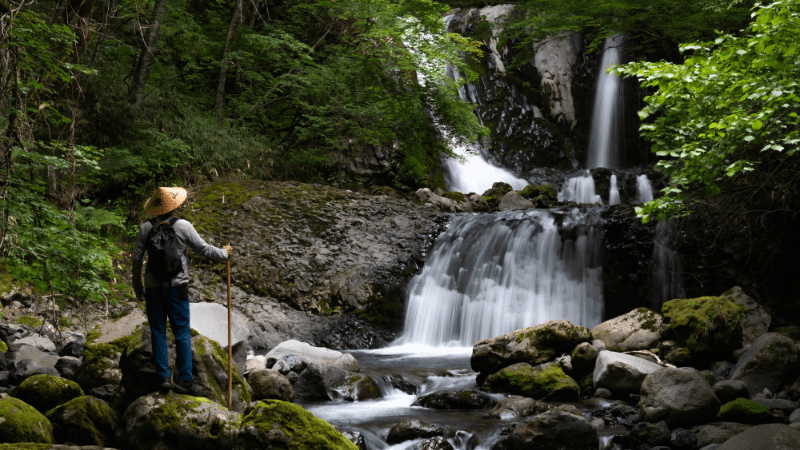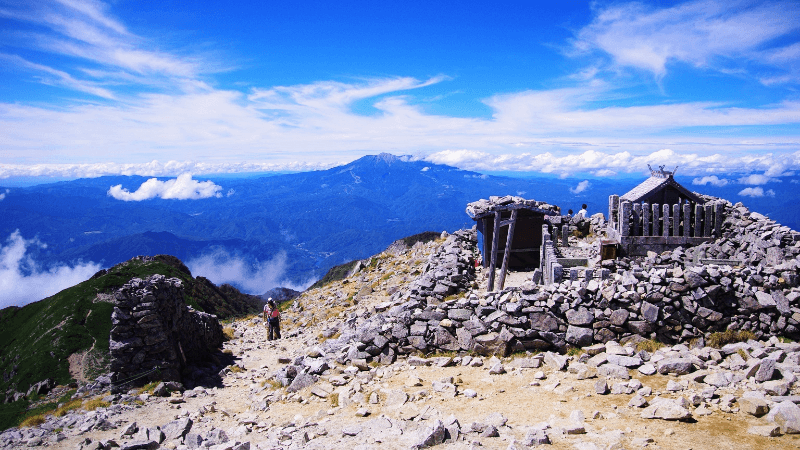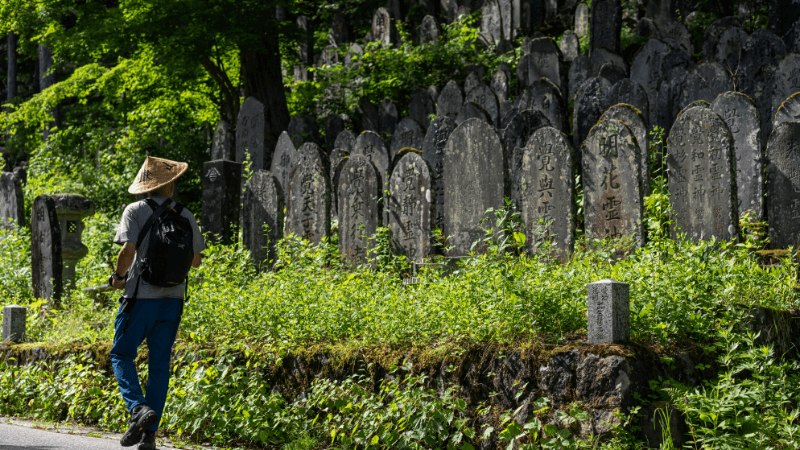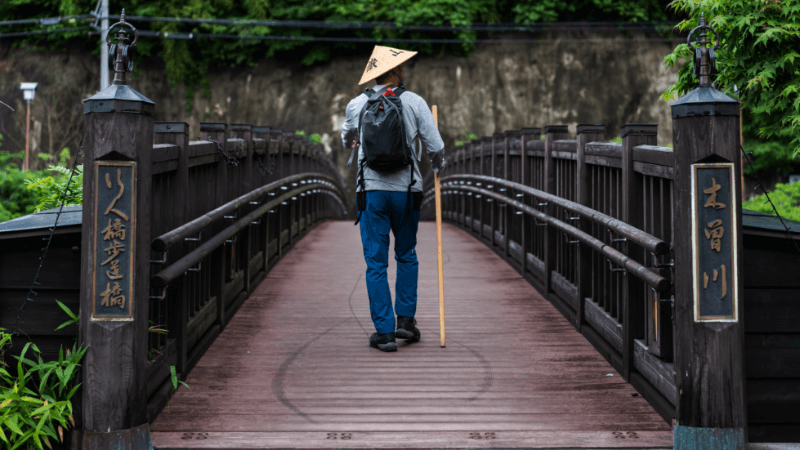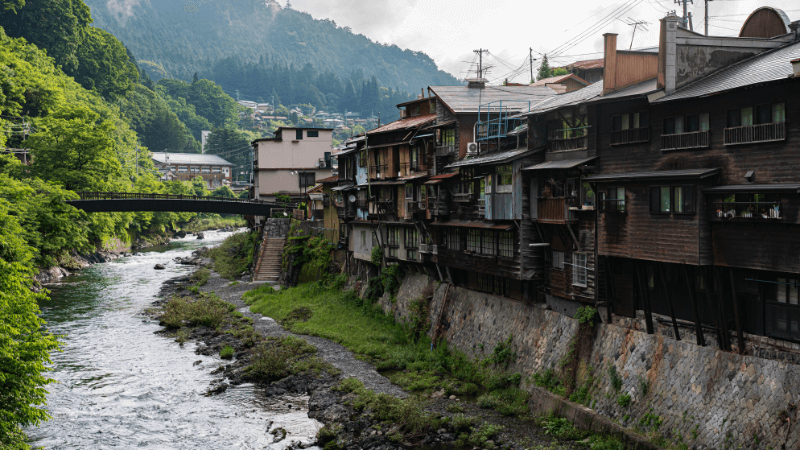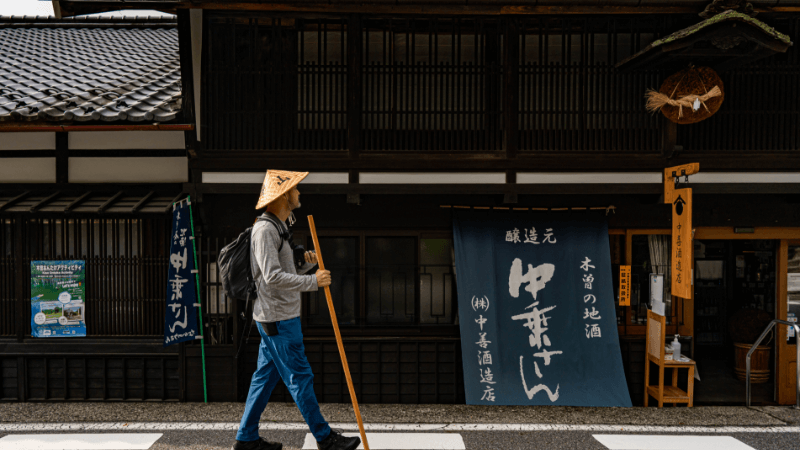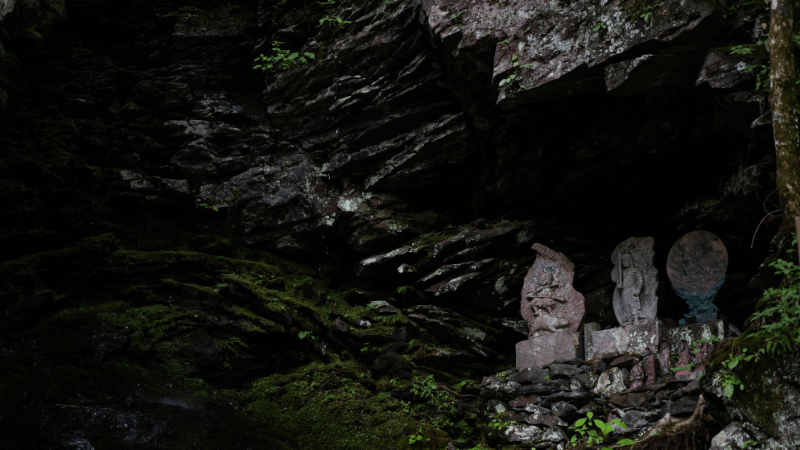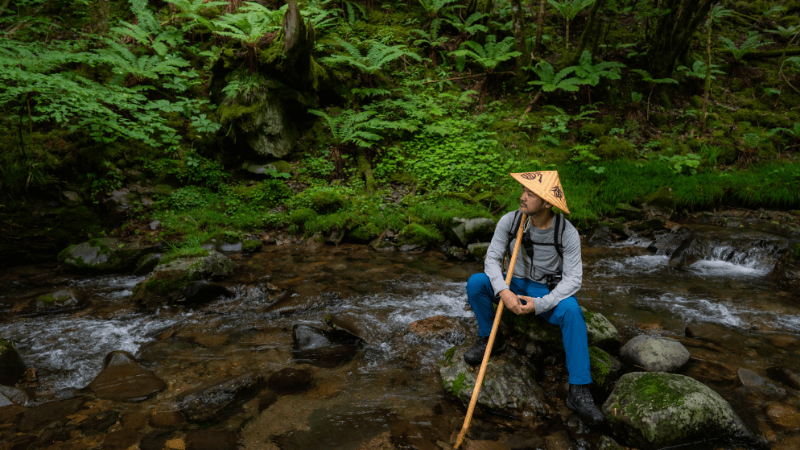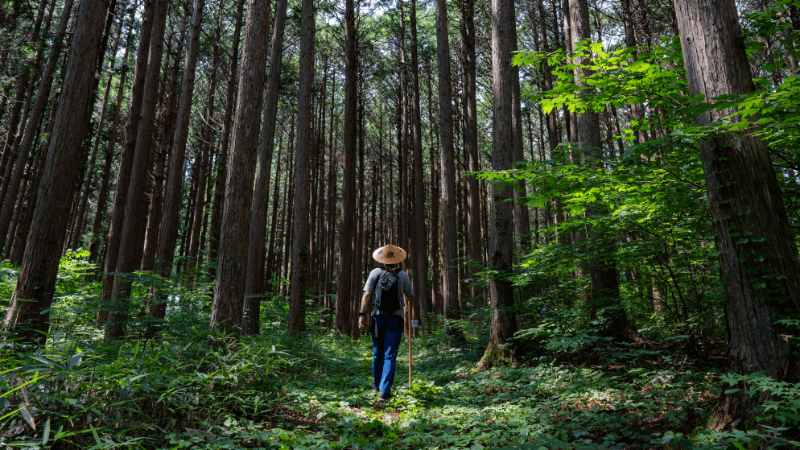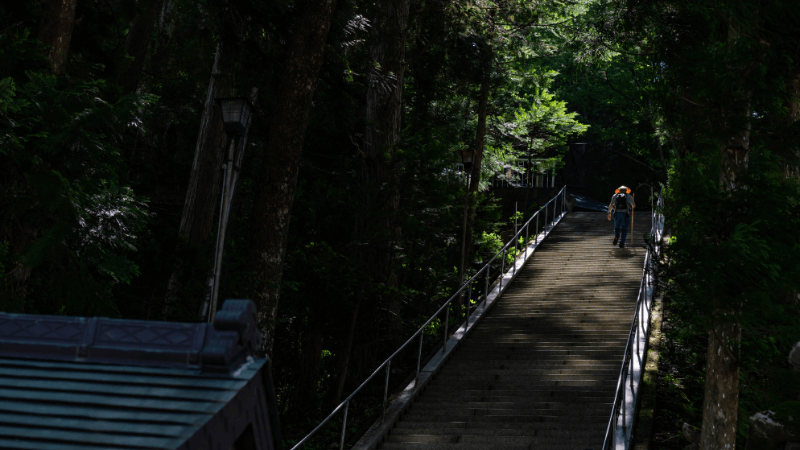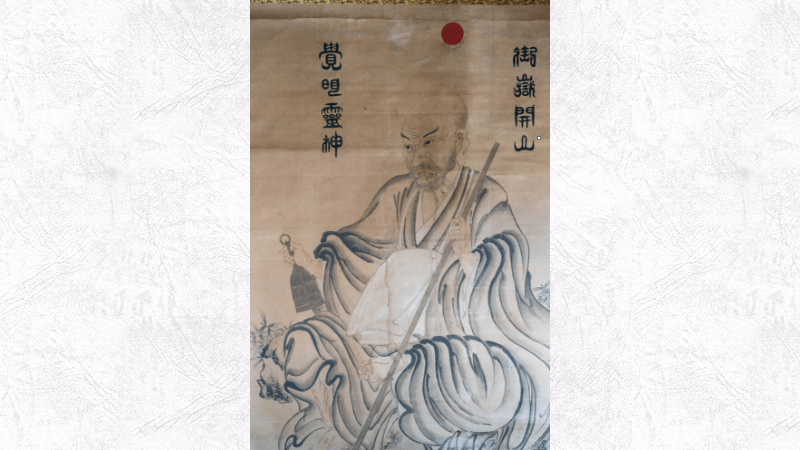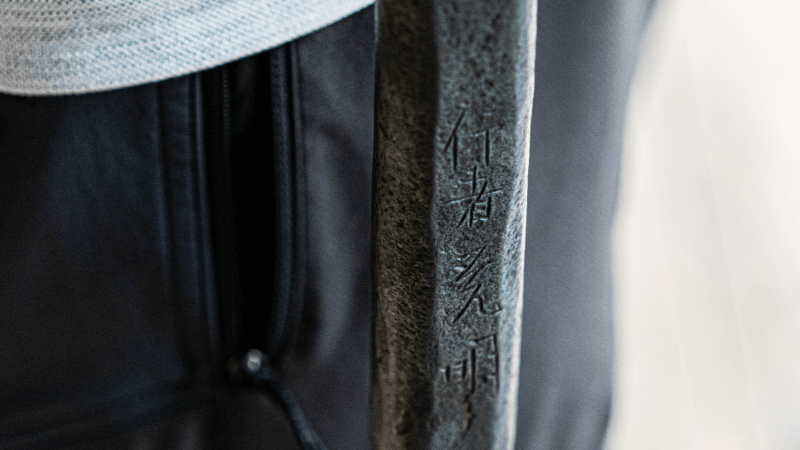 JP
JP

 JP
JP
Starting at the "Gyoninbashi Pedestrian Bridge" in Kiso, the old road with a total length of 26.8 km takes you along a sacred path to "Nakanoyu". Previously only accessible by those that had undergone rigorous training, Kakumei repaired the path in 1782, during the latter half of the Edo period, leading to the path becoming widely known to the general public. The writer, Sei Ouchi, walked along the beautiful ancient path full of history and sacredness with a mysterieous landscape.
1
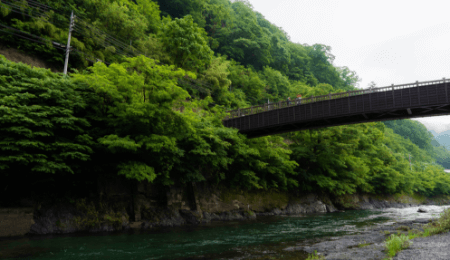
This is a bridge that serves as a starting point for the numerous people that are wish to undergo the pilgramage from the area formerly known as Fukushima-juku (now Fukushima, Kiso Town, Kiso District, Nagano Prefecture) to Kurosawa/Otaki. It also serves as a starting point for the Ontake Highway, and has been a carefully protected entrance to the sacred precincts. The surrounding area is still lined with private houses built on steep riverside cliffs.
Address: 5235 Fukushima, Kiso Town, Kiso District, Nagano Prefecture Google Maps
2
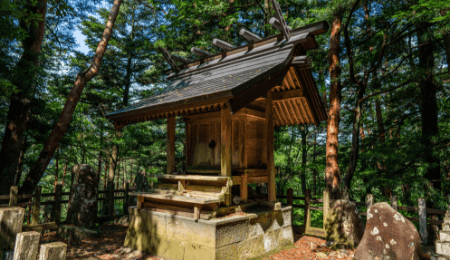
This is a shrine located at the summit of Mt. Kiyomi (900m), on the southern end of the Hachikubo Pass. There is a stone monument, “Mt. Ontake Zao Dai Gongen”, dedicated to Kakumei and Fukan, with 3 shrines that enshrine "Kuninotokotachi-no-Mikoto", "Onamuchi-no-Mikoto", and "Sukunahikona-no-Mikoto". It is a good spot to view Mt. Ontake and prospered as a place of worship.
Address: 7205 Fukushima Kawai, Kiso Town, Kiso District, Nagano Prefecture Google Maps
3
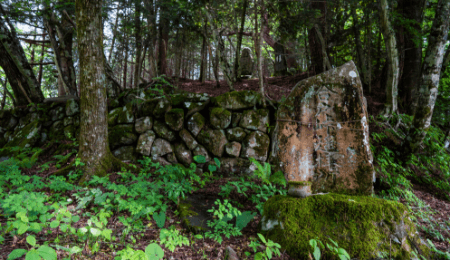
These are the ruins of Yohaijo in Mt. Ontake along the Aido-Toge. With its torii gates, shrines, and teahouses, this spot prospered as a popular resting place for people heading to Mt. Ontake during the golden age of Mt. Ontake worship. Today, the cornerstones of the torii gates and sacred monuments still remain, conveying the remnants of the past. The view of Mt. Ontake on the north side and Mt. Kisokoma on the southeast side is spectacular.
Address: Mitake Shimoden, Kiso Town, Kiso District, Nagano Prefecture Google Maps
4
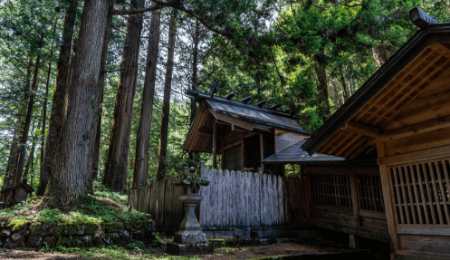
This is an annex located next to the Ontake Satomiya Shrine. Lined with a beautiful cedar grove, there are also ancient dwellings that have been excavated nearby. It is said that the Yabusame Shinto ritual was held along the straight road that stretches through the cedar grove. The shrine is decorated with 36 poems dedicated by the warlord that once ruled the land, Yoshimasa Kiso.
Address: 6189 Mitake, Kisho Town, Kiso District, Nagano Prefecture Google Maps
5

This is a shrine near Hinode Falls. Many sacred monuments have been erected around it, giving way to an atmosphere of being lost in a different world. It is good for praying for the success of children and childbirth, and the custom for pregnant women to bring back sarubobo amulets still exists.
Address: 2841-9 Mitake Yashikino, Kiso Town, Kiso District, Nagano Prefecture Google Maps
6
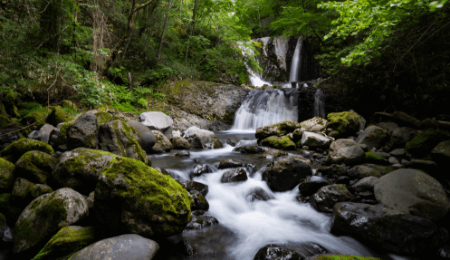
This is a waterfall with a 15m head located along the Yuki Birin Promenade. From the "Hyakkendaki Iriguchi Bus Stop", walk along the promenade about 300m to arrive at the falls. With the clear stream flowing over the moss-covered rocks, the beautiful primitive forest, and the sunlight through the trees, the scenery is truly fantastic. Soaking your tired feet in the clear stream while taking a rest here is highly recommended.
Address: Mitake, Kiso Town, Kiso District, Nagano Prefecture Google Maps
7
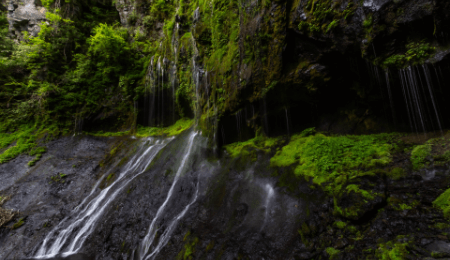
This is a waterfall located about 150 m from “Komorebi Falls” along the "Yuki Birin Promenade". The underground water spouting over the moss-covered rocky surface in countless streaks creates a mysterious landscape. There is a large cavity on the backside of the waterfall, where it is said that pilgrims would undergo training.
Address: Mitake, Kiso Town, Kiso District, Nagano Prefecture Google Maps
Text: Sei Ouchi (Low Mountain Traveler)
Photo: Tomohiko Yoshida
At this moment, I am holding two Maps of Mountains and Plateaus in my hand. One I have kept since 2012 and the other is an updated 2021 version. It might be more accurate to say these are maps of Kiso Ontake. Either way, there are many mountains throughout Japan including the kanji “御嶽.” There are two main readings for this kanji – “Mitake” and “Ontake.” Kiso Ontake uses the latter.
Why do two readings exist? For that matter, what are “mitake” and “ontake” anyway? The answer to this humble question lies in the roots of “mitake.”

Kiso Ontake is a mountain with an overwhelming presence situated on the west side of Mt. Kisokoma. This enormous mountain standing in solitude exuding a regal air akin to a noble king (photo by Sei Ouchi).
“Mitake” means “a mountain where a deity dwells.” If the deity worshiped at a mountain is Zao Gongen, a manifestation of historical figure, En no Ozunu, whose statue is housed at Kinpusen Temple in Yoshino district, Nara, then the mountain is referred to as “mitake.” 御嶽 is not the only kanji used for “mitake.” The other options are 御岳 and 三岳, which are pronounced the same way. Mitake mountains are located throughout Japan and the mitake mountain that represents a specific region is called “kuni-mitake.” For example, Omekanko is the deity-dwelling mountain of Musashi, Tokyo, while Kinpusan is the deity-dwelling mountain of Koshu city.
Of all the kuni-mitake mountains throughout Japan, Kiso Ontake is undeniably the one boasting a scale and grandness to the point that pilgrims who traveled there began calling it “Ono-mitake” or “King Mountain,” in reference to its noble appearance. Over time, people went from saying “Ono-mitake” to “Ontake.” Kiso Ontake was opened to the masses in the late Edo period and was soon bustling with pilgrims bursting with the desire to climb to the summit and pay respects to their deity. As a term of endearment, people began referring to the mountain as “The Ontakesan of Kiso” and that respect and awe remains to this day.
Strangely enough for someone who grew up in Miyagi prefecture far, far from Kiso, the word “Ontake” sounds nostalgic to my ears. No doubt this is because of the Ontake Shrine we had in our hometown. As a child, I used to play in the grounds of that shrine, and as an adolescent, I climbed Kiso Ontake several times. The reason I am holding the map I mentioned in my hand right now is because of that experience in my youth and my personal obsession about climbing that mountain.

Ontake Kodo offers so much charm, not only in terms of its history related to religious faith, but also as a place to experience the culture of pilgrimages and post-towns.
Now, I have returned to Kiso Ontake in my middle-ages. I believe it was a natural outcome for me to suddenly want to revisit this place, which I have been tied to in someway throughout every stage of my life.
They say that “Mt. Fuji” is the grandest mountain, and Ontake (Kiso Ontake) is the grandest peak. Mt. Fuji’s charm is condensed between the 1st and 5th checkpoints but the base of Ontake offers an abundance of charm too. I’ve already marked the must-see spots on my map. There’s Gyojin bridge in Kiso Fukushima, followed by Yakubo Pass, Aido Pass, Ontake Wakamiya and Satomiya shrines, the shrine annex, and the hot springs of the 2nd, 3rd, 4th, and 5th checkpoints. From the mountain villa at the 7th checkpoint, stretches a rope-way converging with the mountain path that ends at Kiso Ontake’s summit.
If one looked at this region from a bird’s eye view, they would see that Kisokomagatake lies to the east and Kiso Ontake lies to the west. Kiso Valley is the enormous terrain shaped by erosion from Kiso River, which flows between the two mountains. This valley is the location of Nakasendo Route and Fukushima-juku Post Station. Ontake Kodo Kurosawa Route begins from Fukushima-juku.
Strolling around this post town, I gain a strong sense of the tradition and culture seen in the architecture, sake and other elements unique to mountainous regions. The development of the Nakasendo Trail brought people and goods together and the heart of the traveler is stimulated by knowing that this land is the result of historical stories and ways of life. No doubt anyone that starts down this path will soon begin to sense the excitement it offers.
The starting point of Kurosawa Route – Gyojin bridge. I pass by here and head up the right bank of Kiso River.
The cliff house masterpieces lining the escarpment are reminiscent of Kyoto’s famous Ine boathouses (funaya).
Nakanorisan is a famous local sake made using the subterranean water from the Ontake Mountain System. Being the Japanese sake lover that I am, I enjoyed not only the post station itself, but also the local produce it had to offer.
There is a kind of power exuded by nature that is only obtainable by walking through mountains. The smell of soil, the sound of wind, the songs of birds, the fragrance of trees, the sunlight filtering through the treetops, the bubbling water over smoothed stones, even the occasional sound of distant thunder all converge to fill the traveler’s heart with good influence and suspense. The mighty power that gently embraced me seem to teach me that I too was an integral part of nature.
Amidst the streams and forests are numerous stone Buddhas and shrines so in harmony with nature that one could easily overlook them. Some are covered in moss. Others lie hidden behind the roots of trees or tangled in wildflowers. These artifacts serve as evidence of faith that someone, at some point in time, intentionally created. Man-made objects that became as one with nature over the centuries. To think that every single one of these objects has its own unique history adds an exhilarating air of mystery to the journey.
A stone Buddha nestled in a cave. If one strains one’s ears into the pure space, the subtle trickle of spring water can be heard.
I stumble across a stream I could get straight down to. Seeing it takes me back to my childhood and fishing in a gorge, which is where my love of mountaineering began.
I walk through the dense cedar and cypress trees as the intense summer sunlight pierces the forest canopy.
The most surprising thing when traveling along Ontake Kodo is undoubtedly the seemingly infinite number of religious monuments (reijin-hi) and statues. Amazingly, these number between twenty and thirty thousand.
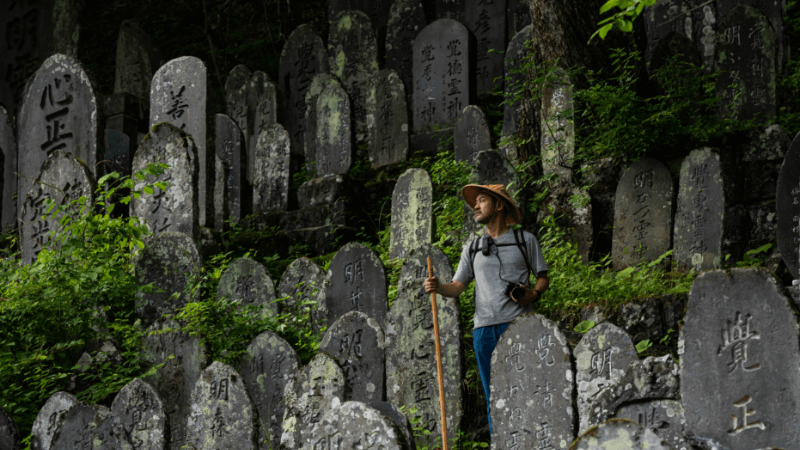
It is difficult to put into words the overwhelming energy of Ontake’s sacred power. It feels so out-of-this-world one might almost believe they are on another planet somewhere.
Reijin-hi are erected in the hope that the souls of those who worshiped Ontake rest peacefully after death. They differ to graves in the aspect that they are objects representative of a divine spirit.
In particular, the leg between Juni Daigongen and Obarai waterfall is breathtakingly beautiful. I stand alone for some time amongst countless reijin-hi monuments, just listening to the silence. The air around me is warm and the atmosphere so peaceful. The reijin-hi exude a sense of life so strong that I almost feel like I am standing amongst real people rather than stone. I absolutely feel like I am floating in space without a single sound and this experience is certainly one that cannot be had merely by climbing Kiso Ontake from the 7th checkpoint bustling with climbers. This feeling alone makes walking Ontake Kodo well worth it.
Guided by the sunlight shining through the trees and lighting the path at my feet, I climb the 108 stone stairs to Ontake Satomiya Shrine.

My journey brings me to the kaisan-do (Founder’s Hall) worshipping Kakumei. Here, the traveler can see firsthand a stone with Kakumei’s very own hand print.
Incidentally, in the past, Kiso Ontake was for a long time regarded as a special sacred mountain and reserved only for those who completed a strict purification ritual lasting one hundred days. During the late Edo period, many of the commoners who had worshiped the deity from the base of the mountain until then began expressing their wish to climb to the summit. The mandatory 100-day purification ritual was an extremely large hurdle for such people. It was then that an ascetic monk Kakumei appeared before the people.
It was not easy to convince those in authority at the time to break tradition in this way, and Kakumei began to open up a path to the mountain’s summit on his own, but people soon joined him as they saw him repeatedly overcome various hardships and challenges, until eventually Kurosawa Route was opened. Thanks to this great endeavor, it became possible for ordinary people to climb the mountain and worship the gods more casually. I believe this exploit by Kakumei was an historic one that made it possible for us to climb sacred mitake mountains today.
As a matter of fact, the shrine annex I stopped at along the way contained a steel staff used by Kakumei until the end of his life. When I held this extremely heavy object in my hand I could practically see Kakumei leading a team up the steep mountain and inspiring them as they cut open a path. This image of Kakumei using this staff to split rocks, support himself, and advance up the mountain gives me much courage.
Kakumei was 48 years old when he aspired to the challenging task of opening a pilgrimage path to Kiso Ontake. Coincidentally, that just so happens to be the age I am now.
View more Otaki Route